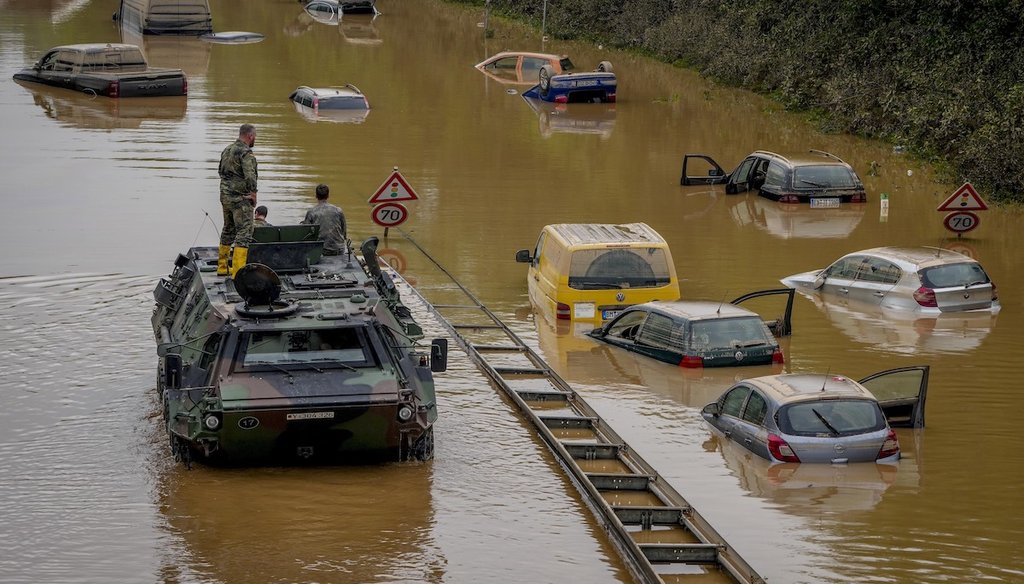Stand up for the facts!
Our only agenda is to publish the truth so you can be an informed participant in democracy.
We need your help.
I would like to contribute

German army soldiers check for victims in flooded cars on a road in Erftstadt, Germany, after strong rainfall caused the Erft river to overflow, causing massive damage. (AP Photo/Michael Probst)
If Your Time is short
-
Scientists are able to say with greater certainty whether climate change made extreme weather events more likely — and they can estimate its role in making those events worse.
-
Not every climate disaster is 100% driven by climate change, but science is better at identifying when it is.
In quick succession, severe weather walloped towns and cities on three continents. In June, the thermometer hit 112 degrees in Portland, Ore., the result of an atmospheric anomaly called a heat dome. Then heavy rains brought floods to Germany and Belgium. And a July storm in China dumped a year’s worth of rain in four days, unleashing flooding in China that left scores dead.
The list could go on, with brush fires, additional heat waves and droughts elsewhere.
"Climate effects that we thought were going to happen in the middle of the century are happening right this minute," Transportation Secretary Pete Buttigieg told MSNBC July 18. A New York Times op-ed headline read, "That Heat Dome? Yeah, It’s Climate Change."
In a landmark report from the Intergovernmental Panel on Climate Change, released Aug. 9, 234 authors relying on more than 14,000 studies stated that "it is unequivocal that human influence has warmed the atmosphere, ocean and land." It also said that some recent extreme weather events would be highly unlikely without this warming.
As recently as a decade ago, it was considered analytically risky to tie climate change to this flood, or that heat wave. Can we safely do that now?
Not every climate disaster is 100% driven by climate change, but science is getting better at identifying when they are. The IPCC report said that it has "high confidence" that the main driver of increased frequency and intensity of hot extremes experienced over most land regions since the 1950s is human-induced climate change. It is also "likely," the report said, that human influence has resulted in a greater frequency of concurrent heatwaves and droughts on the global scale, fires in some regions and compound flooding in some places.
But what does that mean we can say about specific storms, fires, floods and heat waves?
"The question that is always asked by the media and the public about an impactful storm is, ‘Is this storm due to climate change?’" said atmospheric scientist Kevin Reed at Stony Brook University. "That is a question scientists will never be able to answer adequately."
The better question, Reed says, is to ask how climate change shaped a particular weather event.
Which brings us to the evolving discipline of weather attribution science. It comes in different forms, and its practitioners debate the best approaches among themselves. But since about 2015, it has woven itself into the climate change research community.
While naysayers still exist, it’s settled science that human activity has and continues to change the climate baseline. Even the partisan divide has faded somewhat. In June, Utah Republican Rep. John Curtis formed the Conservative Climate Caucus to get his Republican colleagues on board.
"The climate is changing, and decades of a global industrial era that has brought prosperity to the world has also contributed to that change," Curtis wrote when he launched the group.
Climatologists are increasingly confident about drawing lines between a particularly dramatic episode and the broader shifts that come from decades of pumping carbon into the atmosphere. That’s not to say that the numbers or data say that every extreme weather event is driven by putting carbon into the atmosphere.
"There are many generalities about how we expect the weather to change under global warming," said climate scientist Friederike Otto at the University of Oxford Environmental Change Institute. "In practice, local factors often also affect these extremes and other weather in different directions than the generalities would indicate."
Otto co-directs an international group of researchers called World Weather Attribution and was one of the contributors to the IPCC report. She said that she and her colleagues have found it particularly difficult in most cases to establish a connection with droughts. Some floods were clearly made worse by warmer air and its ability to hold more water, but not all floods.
But sometimes, as in the case of the heat wave that recently hit the Pacific Northwest, the numbers are pretty convincing.
Otto’s group found that those high temperatures in Oregon, Washington and British Columbia were "virtually impossible without human-caused climate change."
Researchers used a blend of climate computer modeling and the history of daily highs across the region going back to 1900. The heat readings were so beyond what had come before, analysts couldn’t put a firm number to how rare they were. But based on the assumption that this represented a once in a 1,000 year event, they found that human-induced climate change made it 150 times more likely.
The results of attribution studies come in the form of probabilities. An analysis of 2019 flooding in Canada said humans’ affect on the climate contributed to heavy rains by a factor of 2 to 3. Warmer winters in Central England the same year were 300 times more likely.
Many of these studies rely on comparing what did happen to what didn’t. The second half of that comparison comes out of computer models that say what the temperature or rainfall would have been without as much carbon in the air. Those models are the workhorse of climate studies, and while some skeptics challenge them, Otto said her group constantly tweaks them to align them with actual weather data. Still, there is always a measure of uncertainty.
The differences that emerge might not appear large. Reed, the Stony Brook University scientist, looked at rainfall from hurricane Dorian in 2019, and reported that climate change increased the amount of rain by 16%. If that seems manageable, Reed noted that the increase comes on top of the huge rains a hurricane brings.
"For a hurricane, a 5% difference can be an additional one inch of rain over the course of the storm," Reed said. "That one inch can be the difference between your home or business flooding, a levee failing, or a seawall being overcome."
Weather attribution researchers can deploy an alternative approach. Rather than estimate what the weather might have been, they rely on things everyone can measure, such as sea level and surface temperature and moisture in the air. Those factors, they say, create the conditions that make any extreme event worse.
Climate scientist John Fasullo at the National Center for Atmospheric Research co-authored a study on weather attribution that drew on the impact of 2012 Superstorm Sandy. Higher sea surface temperatures produced "a bigger more intense storm, stronger winds and greater precipitation," the researchers wrote. Even if only a third of the temperature rise was due to humans, they said, it was enough to greatly increase the damage.
Fasullo, whose research is frequently cited in the IPCC report, said the pure physics of how the air and water interact makes conclusions about climate change’s impact inescapable.
"Perhaps the biggest error I see being made frequently in the media is the repetition of the idea that we can't attribute any single event to climate change," Fasullo said. "In fact, we can now quantify the contribution of climate change to event likelihood in many cases."
Some argue that extreme events aren’t the best way to understand climate change. By definition, they are outliers, which don’t reflect the more average state of the world.
But Reed said analyzing such events serves an important purpose.
"It communicates that the impacts of climate change are real," Reed said. "Climate change is often communicated as a future problem, which it is, but it is also a current problem."
Our Sources
Intergovernmental Panel on Climate Change, Sixth Assessment Report, accessed Aug. 9, 2021
MSNBC, Interview with Transportation Secretary Pete Buttigieg, July 18, 2021
New York Times, That Heat Dome? Yeah, It’s Climate Change., June 29, 2021
Rep. John Curtis, Conservative Climate Caucus, June 23, 2021
Climate Signals, Northwest Pacific Heat Wave June 2021, June 28, 2021
Current Climate Change Reports, A Common Framework for Approaches to Extreme Event Attribution, Feb. 18, 2016
Carbon Brief, Climate change attribution studies are asking the wrong questions, study says, June 22, 2015
Climatic Change, Climate change attribution and legal contexts: evidence and the role of storylines, Aug. 2, 2021
Natural Hazards and Earth System Science, Attribution of the Australian bushfire risk to anthropogenic climate change, March 11, 2021
Nature, Heed blame for extreme weather, Jan. 26, 2021
American Meteorological Society, Explaining Extreme Events in 2019 from a Climate Perspective, January 2021
World Weather Attribution, Western North American extreme heat virtually impossible without human-caused climate change, July 7, 2021
World Weather Attribution, Siberian heatwave of 2020 almost impossible without climate change, July 15, 2020
Deutsche Welle, Flooding in Germany: Before and after images from the Ahr and Eifel regions, July 17, 2021
Email exchange, Kevin Reed, associate professor, School of Marine Atmospheric Sciences, Stony Brook University, July 28, 2021
Email exchange, John Fasullo, project scientist, National Center for Atmospheric Research, Aug. 4, 2021
Email exchange, Friederike Otto, associate director, Environmental Change Institute, University of Oxford, July 21, 2021




















































